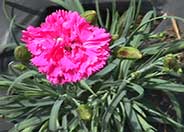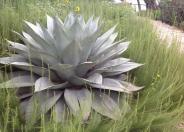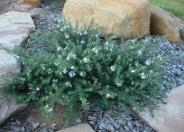
Common name:Carnation, Clove Pink, Pinks
Botanical name:Dianthus caryophyllus
Dianthus caryophyllus is a perennial. Produces double flowers, bluish green leaves, and leafy stems that often become woody at the base.

Common name:Catmint
Botanical name:Nepeta X faassenii
Nepeta faassenii makes soft, gray green, undulating mounds that are 1.5' high when blooming. The small leaves are attractive to cats. This perennial has lavender blue flowers in late spring and early summer.

Common name:Dark Leaf Aeonium
Botanical name:Aeonium arboreum 'Zwartkop'
Aeonium arboreum 'Zwartkop' is a succulent perennial that is used for accenting effect. Aeonium arboreum grows 3' tall and wide. Each branch has a 6"-8 " wide rosette of dark green, fleshy leaves.The flowers are yellow in clusters.

Common name:Whale's Tongue Agave
Botanical name:Agave ovatifolia
This versatile Agave is a solitary plant, growing quite large, with rosettes that can reach 7' across. Leaves are grayish white color with small marginal teeth. The leaf blade is short, wide and distinctively cupped, thus the common name, Whale's Tongue. This Agave looks great in a pot on a patio, under trees, with large boulders or planted with other succulents. It can take intense heat and cold. It grows moderately fast but prefers well drained soil.

Common name:Oriental Fountain Grass
Botanical name:Pennisetum orientale
Oriental Fountain Grass is a clumping, warm-season grass with spectacular pink flowers.

Common name:Mundi Rosemary
Botanical name:Westringia fruticosa 'Mundi'
A great groundcover form of coastal rosemary. Used as a specimen or in mass, Mundi is great for tough roadsides and residential gardens alike. Best suited to Zones 9-11 in arid climates although Mundi continues to show potential for low water gardens in humid regions. It’s super short height and infrequent pruning requirement distinguish Mundi from other Westringia currently on the market. Coastal rosemary, so named for its rosemary-like leaves, is a drought and salt tolerant shrub that works well in coastal plantings. Some Westringia varieties, including Mundi, are also proving to be adapt to humid, subtropical climates of the southeastern US. So while Westringia are best suited to Mediterranean climates.
Designer: Susan Morrison
Photographer: Vicki Anderson
Maintain a two to four inch layer of mulch on the soil surface to reduce weeds, infiltrate rain water, and reduce compaction.
Group plants in your garden according to their water needs (hydrozone).
Attract, or buy beneficial insects such as ladybugs and lacewings to control pest outbreaks in your garden.